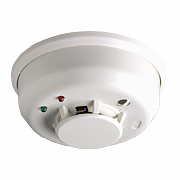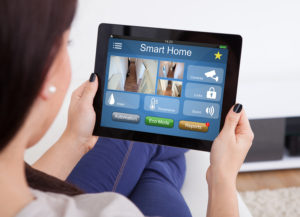Well, spring has arrived and you all adjusted your clocks for daylight saving time. While you were at it, did you also remember to change the batteries in your smoke and carbon monoxide alarms as well? Changing batteries in these devices every time you reset your clocks is a good routine to get into. Battery operated alarms do offer some protection, as long as they are maintained properly. But they do have some serious drawbacks to consider. First, you must test them on a regular basis to determine if they are working properly.  Second, you must replace the batteries regularly, which cost money and can become a real pain. So much so, that many people just stop doing it. That’s not smart. Finally, these devices only sound locally and do not transmit a signal for help. Someone must be nearby to hear them and then call for help. That’s only part time protection. Why not consider full time protection with less hassle? Smoke and carbon monoxide detectors that connect directly to your alarm system will monitor your home or office and summon help 24/7, whether you’re there or not. The faster you can get the help you need, the safer you and your family will be. Call us to discuss the type of detectors that are right for you. Why settle for only part time protection?
Second, you must replace the batteries regularly, which cost money and can become a real pain. So much so, that many people just stop doing it. That’s not smart. Finally, these devices only sound locally and do not transmit a signal for help. Someone must be nearby to hear them and then call for help. That’s only part time protection. Why not consider full time protection with less hassle? Smoke and carbon monoxide detectors that connect directly to your alarm system will monitor your home or office and summon help 24/7, whether you’re there or not. The faster you can get the help you need, the safer you and your family will be. Call us to discuss the type of detectors that are right for you. Why settle for only part time protection?
Clients with remote access and control of their video, alarm and automation systems, should be aware that changes or updates made to your cellphone software, internet service, computer or router settings, may adversely affect your ability to remotely connect to your system. We reminded you that we do not provide these services or updates to you and we do not guarantee or warranty their operation, or the operation of your system if it is affected by these changes. Should you experience any connectivity issues, you are advised to contact your cell or internet service providers first before calling us. If you still require our services to reprogram your system, please contact our office to arrange for service and related fees and details.
Wireless technology has given everyone a whole new world of conveniences, and smart locks are just one of the latest examples. With the introduction of smart locks, we no longer need to carry around a ring full of keys to unlock doors or worry that our child is  locked out of the house. Forget about leaving a key under the door mat or under an outside planter. Now, you can control any door lock from almost any location. When you’re away from home, use your cellphone to remotely disarm your alarm system and unlock the door. When you are home, the smart lock functions as a standalone feature or it can be networked as an integrated feature of your alarm automation capabilities. Smart locks are available in a variety of lock configurations, colors, styles, features and they also include complete backup and fail-safe capabilities.
locked out of the house. Forget about leaving a key under the door mat or under an outside planter. Now, you can control any door lock from almost any location. When you’re away from home, use your cellphone to remotely disarm your alarm system and unlock the door. When you are home, the smart lock functions as a standalone feature or it can be networked as an integrated feature of your alarm automation capabilities. Smart locks are available in a variety of lock configurations, colors, styles, features and they also include complete backup and fail-safe capabilities.
SkyBell is another of the new smart video/intercom doorbell systems that utilize wireless technology. With SkyBell you can see, hear, and speak with someone at your door, whether you’re at home, at work, or on the go. As someone approaches your door, SkyBell sends a live video feed to your smartphone to alert you. It can also be setup to work with a smart lock when integrated as a home automation feature, using Honeywell’s Total Connect remote service.
Honeywell Total Connect is a surprisingly affordable remote service that lets you stay in the know wherever you go. With the tap of your finger, you can control your security system, video alerts, receive notifications, email, view  live video, control the SkyBell video doorbell, view events, locate vehicles or assets, control thermostats, lighting, smart locks and more anytime, anywhere from any mobile device. Call us for more details.
live video, control the SkyBell video doorbell, view events, locate vehicles or assets, control thermostats, lighting, smart locks and more anytime, anywhere from any mobile device. Call us for more details.
Cellphone owners know that the higher the pixel count of their cellphone camera, the better their pictures will be. Well, the same is also true for video surveillance cameras. Advancements have once again greatly improved picture quality while expanding digital capabilities. Current digital features dwarf those delivered by systems installed only a few years ago, making older systems less relevant from a productivity and security point of view. Previously, owners of these legacy systems who wanted to take advantage of the newest digital technology were forced to upgrade their entire system. This included replacing not only the video equipment, but the cable infrastructure as well. This is no longer the case! Now, depending upon the integrity of that infrastructure, legacy systems can be retrofitted to take advantage of many enhanced digital capabilities such as 4-K picture resolution, twelve mega-pixel camera resolution, a camera with a 360-degree view, enhanced digital zoom, increased storage time and more. Due to greatly reduced material and labor costs, legacy owners will find that upgrading their older system is far more affordable now
Time is up! Recently a client inadvertently tripped their alarm but did not receive a call from the monitoring company. It was determined that the client had switched their phone service to digital service and did not inform us. Because of the switch, their alarm system was no longer able to report to the monitoring company. Had this been a real emergency, they could have been in serious trouble. Fortunately, the solution to this problem was to install an alarm cellular radio. Now their system communicates directly with the monitoring company and does not rely on internet or phone services. These radios are powered by the alarm panel and are not affected by minor power failures or outages, which will affect cable services. If you’ve switched over to digital phone service and have not told us yet, you may have local alarm service only, and may not be sending alarm signals to the monitoring company. You are advised to contact us to arrange for a review of your system so we can determine its status. There is no charge for the review.
UPDATE YOUR ACCOUNT: Once again, we ask our clients to update the account information we have on file for them. Many of the services that we provide depend upon information given to us when we first set up your account. Over time, if changes to that information have been made, we would like you to contact us as soon as possible so we can update our records. Some of these changes might be your e-mail address, cell number or the number the monitoring company uses to contact you, or if you’ve gone digital or changed your phone provider. If your phone is now answered by an answering machine or if you need to make changes to the names or phone numbers of the people you want notified in the event of an alarm condition. Incorrect or outdated data on your account will always delay assistance getting to you in a timely manner. Please contact us soon so we can review your information.
